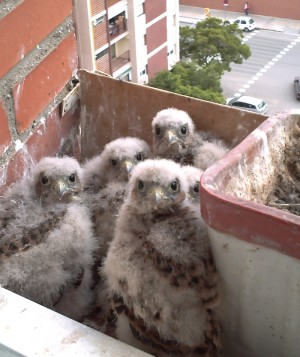Most of the species that nest in buildings are birds of prey. Alpine and common swifts, swallows and bats usually eat small insects. In this sense, the role they play is vital.

Nesting site for swifts on a building in the Horta district. After making the long journey from the African regions where they spend winter, falcons and swifts return to the city in spring, always seeking out their breeding sites in the same buildings, as is the case with other species.
Photo: Sergi Garcia
The spring sky over the city is still teeming with common and alpine swifts. Their shrill, ear-piercing whistles are hardly noticed by the locals, maybe because they are used to this unavoidable cycle, repeated punctually every spring, or maybe because the noise of the city drowns them out. But these birds, after making an incredibly long journey from the remote parts of Africa where they spend the winter, arrive in the city looking for their regular nesting spots on buildings, because for these and other species, such as falcons, kestrels, swallows, bats and even all the little Mediterranean house geckos, so unjustly hunted, our buildings are their home and, like us, they dislike change.
From a biological point of view, buildings are like cliff faces; the geographical formations where these species nest outside of cities. Here they find holes, cornices and ledges on which to build their nests, some of which are very elaborate, like those of the swallows, and others less so. Falcons and kestrels do not build a nest at all; the females lay their eggs straight onto a surface that can be completely bare.
The species that nest or take shelter in buildings are rock dwellers, in other words, they live in structures made out of rocky material or that have a similar look or composition. Alpine and common swifts, swallows and bats are big consumers of small insects. In this sense, the role they play is vital. An alpine swift, a bird that flies at dizzying heights but with great accuracy, can catch dozens of pine processionary moths a day, thus helping to control this pest that affects the woods where we might go mushroom picking. In a single day, bats can eat a third of their own bodyweight in mosquitos and other small creatures: one colony of these winged mammals can consume a massive amount of insects each season. Falcons have a particular weakness for pigeons. Falcons and pigeons are like the cat and mouse of the air. They learn from each other: some to escape and others to hunt. Kestrels prefer small rodents and large insects.
But these creatures do not have it easy in today’s busy society. They used to be much more highly respected than they are now (swallows were almost worshipped). Today, they no longer are, and herein lies the key to their conservation: tolerance. Very often when buildings are renovated, the opportunity is taken to close up the holes in which they have lived for generations, or spikes are fitted to keep them away and force them to look for alternative homes that are often deadly (for example, the common swifts that are banished from their regular dwellings take up residence in kitchen extractors). And to top it all off, new architecture that pays so much attention to energy and sustainability issues, completely ignores the aspect of biodiversity and is more and more hermetically sealed. Furthermore, lots of glazing is often used on the facades, and these vast shiny surfaces become traps that many, many birds crash into.
There is no easy solution to all of these problems but it would entail, for example, keeping holes open or adjusting their size instead if the problem is too many pigeons. It could include establishing a set of regulations to prevent the installation of unnecessary obstacles or building integrated artificial nests in order to ensure the survival of these creatures whose presence guarantees a certain environmental quality that we need, as well as a vital source of joy. As Joan Manuel Serrat says in his song Els falciots (The Swifts): “…when the swifts fly away, the sky weeps…”



